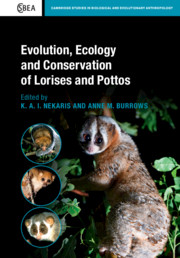Book contents
- Evolution, Ecology and Conservation of Lorises and Pottos
- Cambridge Studies in Biological and Evolutionary Anthropology
- Evolution, Ecology and Conservation of Lorises and Pottos
- Copyright page
- Dedication
- Contents
- Contributors
- Foreword
- Acknowledgements
- 1 Introduction
- Part I Evolution, Morphology and the Fossil Record
- Part II Ecology and Captive Management
- 13 Nutrition of Lorisiformes
- 14 Seeing in the Dark
- 15 Thermoregulation in Lorises
- 16 Home Range, Activity Budgets and Habitat Use in the Bengal Slow Loris (Nycticebus bengalensis) in Bangladesh
- 17 Behaviour of Pottos and Angwantibos
- 18 Positional Behaviour and Substrate Preference of Slow Lorises, with a Case Study of Nycticebus bengalensis in Northeast India
- 19 Sexual Differences in Feeding and Foraging of Released Philippine Slow Loris (Nycticebus menagensis)
- 20 Ranging Patterns of the Pygmy Slow Loris (Nycticebus pygmaeus) in a Mixed Deciduous Forest in Eastern Cambodia
- 21 Utilising Current and Historical Zoo Records to Provide an Insight into the Captive Biology of the Rarely Kept Species Pottos and Angwantibos
- 22 Mother–Infant Behaviours in Greater Slow Loris (Nycticebus coucang) Dyads Consisting of Mothers Pregnant at Confiscation and Their Sanctuary-Born Infants
- 23 Husbandry and Reproductive Management Recommendations for Captive Lorises and Pottos (Nycticebus, Loris and Perodicticus)
- Part III Research, Trade and Conservation
- References
- Index
23 - Husbandry and Reproductive Management Recommendations for Captive Lorises and Pottos (Nycticebus, Loris and Perodicticus)
from Part II - Ecology and Captive Management
Published online by Cambridge University Press: 29 February 2020
- Evolution, Ecology and Conservation of Lorises and Pottos
- Cambridge Studies in Biological and Evolutionary Anthropology
- Evolution, Ecology and Conservation of Lorises and Pottos
- Copyright page
- Dedication
- Contents
- Contributors
- Foreword
- Acknowledgements
- 1 Introduction
- Part I Evolution, Morphology and the Fossil Record
- Part II Ecology and Captive Management
- 13 Nutrition of Lorisiformes
- 14 Seeing in the Dark
- 15 Thermoregulation in Lorises
- 16 Home Range, Activity Budgets and Habitat Use in the Bengal Slow Loris (Nycticebus bengalensis) in Bangladesh
- 17 Behaviour of Pottos and Angwantibos
- 18 Positional Behaviour and Substrate Preference of Slow Lorises, with a Case Study of Nycticebus bengalensis in Northeast India
- 19 Sexual Differences in Feeding and Foraging of Released Philippine Slow Loris (Nycticebus menagensis)
- 20 Ranging Patterns of the Pygmy Slow Loris (Nycticebus pygmaeus) in a Mixed Deciduous Forest in Eastern Cambodia
- 21 Utilising Current and Historical Zoo Records to Provide an Insight into the Captive Biology of the Rarely Kept Species Pottos and Angwantibos
- 22 Mother–Infant Behaviours in Greater Slow Loris (Nycticebus coucang) Dyads Consisting of Mothers Pregnant at Confiscation and Their Sanctuary-Born Infants
- 23 Husbandry and Reproductive Management Recommendations for Captive Lorises and Pottos (Nycticebus, Loris and Perodicticus)
- Part III Research, Trade and Conservation
- References
- Index
Summary
Lorisids must be carefully managed both in the wild and ex situ to ensure their continued survival. The Asian lorisines are rapidly diminishing in native habitats (Nekaris et al., 2010b), and while perodicticines are currently listed as Stable in the IUCN Red list of Threatened Species (IUCN, 2018), the lack of habitat will prove to be a threat to their long-term survival as African rainforests are being eroded (Pimley and Bearder, 2013). Most zoo and research populations are declining as well. Of all the lorisids, pygmy lorises (Nycticebus pygmaeus) currently have the best chance of attaining a self-sustaining ex-situ population. Although there are fewer than 50 pygmy lorises remaining in North America (Species360, 2018), an additional 150-plus animals are housed in facilities throughout Europe and Asia, thus enhancing opportunities for their ex-situ breeding management and genetic diversity.
- Type
- Chapter
- Information
- Evolution, Ecology and Conservation of Lorises and Pottos , pp. 263 - 276Publisher: Cambridge University PressPrint publication year: 2020
- 4
- Cited by



